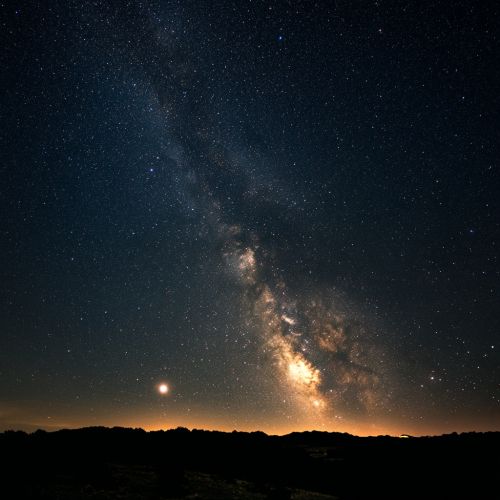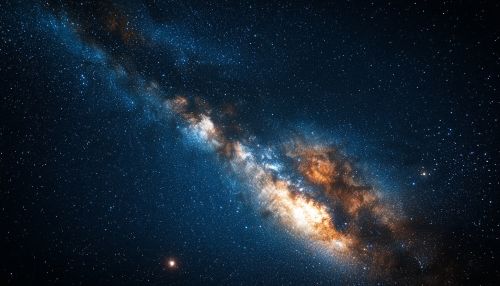Gravitational force: Difference between revisions
(Created page with "== Introduction == Gravitational force, also known as gravity, is a fundamental interaction that causes mutual attraction between masses. This force is responsible for the structure and behavior of astronomical bodies and systems, ranging from planets and stars to galaxies and the universe as a whole. Gravitational force plays a crucial role in various physical phenomena and is described by the general theory of relativity as well as Newton's law of universal gravitation...") |
No edit summary |
||
| Line 66: | Line 66: | ||
== References == | == References == | ||
[[Image:Detail-97999.jpg|thumb|center|A picturesque view of a starry sky with a visible galaxy and celestial bodies.|class=only_on_mobile]] | |||
[[Image:Detail-98000.jpg|thumb|center|A picturesque view of a starry sky with a visible galaxy and celestial bodies.|class=only_on_desktop]] | |||
[[Category:Physics]] | [[Category:Physics]] | ||
[[Category:Astronomy]] | [[Category:Astronomy]] | ||
[[Category:Cosmology]] | [[Category:Cosmology]] | ||
Latest revision as of 20:44, 15 September 2024
Introduction
Gravitational force, also known as gravity, is a fundamental interaction that causes mutual attraction between masses. This force is responsible for the structure and behavior of astronomical bodies and systems, ranging from planets and stars to galaxies and the universe as a whole. Gravitational force plays a crucial role in various physical phenomena and is described by the general theory of relativity as well as Newton's law of universal gravitation.
Historical Background
The concept of gravitational force has evolved significantly over time. The ancient Greeks, including Aristotle, believed that objects fall due to their natural place in the universe. However, it was Sir Isaac Newton who formulated the first comprehensive theory of gravity in the 17th century. Newton's law of universal gravitation states that every point mass attracts every other point mass by a force acting along the line intersecting both points. This force is proportional to the product of the masses and inversely proportional to the square of the distance between them.
In the early 20th century, Albert Einstein revolutionized our understanding of gravity with his general theory of relativity. According to Einstein, gravity is not a force but a curvature of spacetime caused by the presence of mass and energy. This theory has been confirmed by numerous experiments and observations, including the bending of light by gravity and the precise orbit of Mercury.
Newton's Law of Universal Gravitation
Newton's law of universal gravitation can be mathematically expressed as:
\[ F = G \frac{m_1 m_2}{r^2} \]
where:
- \( F \) is the gravitational force between two masses,
- \( G \) is the gravitational constant (\(6.67430 \times 10^{-11} \, \text{m}^3 \, \text{kg}^{-1} \, \text{s}^{-2}\)),
- \( m_1 \) and \( m_2 \) are the masses of the two objects,
- \( r \) is the distance between the centers of the two masses.
This equation implies that the gravitational force is always attractive and acts along the line joining the centers of the two masses. It also highlights the inverse-square law nature of gravity, meaning the force decreases rapidly with increasing distance.
General Theory of Relativity
Einstein's general theory of relativity provides a more comprehensive description of gravitational phenomena. According to this theory, mass and energy cause the fabric of spacetime to curve, and this curvature dictates the motion of objects. The Einstein field equations, which form the core of general relativity, are given by:
\[ R_{\mu\nu} - \frac{1}{2} R g_{\mu\nu} + \Lambda g_{\mu\nu} = \frac{8 \pi G}{c^4} T_{\mu\nu} \]
where:
- \( R_{\mu\nu} \) is the Ricci curvature tensor,
- \( R \) is the scalar curvature,
- \( g_{\mu\nu} \) is the metric tensor,
- \( \Lambda \) is the cosmological constant,
- \( T_{\mu\nu} \) is the stress-energy tensor,
- \( c \) is the speed of light in a vacuum.
These equations describe how matter and energy influence the curvature of spacetime, which in turn affects the motion of objects. One of the most famous predictions of general relativity is the existence of black holes, regions of spacetime where the gravitational field is so intense that nothing, not even light, can escape.
Gravitational Waves
Gravitational waves are ripples in spacetime caused by the acceleration of massive objects. Predicted by Einstein's general theory of relativity, these waves propagate at the speed of light and carry information about their origins. Gravitational waves were first directly detected by the LIGO and Virgo collaborations in 2015, confirming a key prediction of general relativity. These detections have opened a new window into the universe, allowing scientists to study phenomena such as binary black hole mergers and neutron star collisions.
Applications and Implications
Gravitational force has numerous applications and implications in various fields of science and engineering. In astronomy, gravity governs the motion of celestial bodies and the formation of structures in the universe. In geophysics, it influences the behavior of Earth's atmosphere, oceans, and interior. Gravitational force is also crucial in space exploration, as it dictates the trajectories of spacecraft and the orbits of satellites.
In cosmology, gravity plays a central role in the evolution of the universe. The study of gravitational interactions helps scientists understand the formation and distribution of galaxies, the behavior of dark matter and dark energy, and the ultimate fate of the universe.
Experimental Evidence
Numerous experiments and observations have confirmed the predictions of both Newtonian gravity and general relativity. Some of the key experimental evidence includes:
- The precise measurement of planetary orbits, which align with Newton's law of universal gravitation.
- The perihelion precession of Mercury, which is accurately explained by general relativity.
- The deflection of light by gravity, observed during solar eclipses and confirmed by gravitational lensing.
- The time dilation effects observed in the vicinity of massive objects, consistent with general relativity.
- The direct detection of gravitational waves by LIGO and Virgo.
Challenges and Open Questions
Despite the success of Newtonian gravity and general relativity, several challenges and open questions remain. One of the major challenges is the unification of gravity with the other fundamental forces of nature. While general relativity describes gravity on a macroscopic scale, quantum mechanics governs the behavior of particles on a microscopic scale. The development of a quantum gravity theory that reconciles these two frameworks is an ongoing area of research.
Another open question is the nature of dark matter and dark energy, which constitute the majority of the universe's mass-energy content. While their gravitational effects are well-documented, their exact nature remains unknown.
See Also
References


